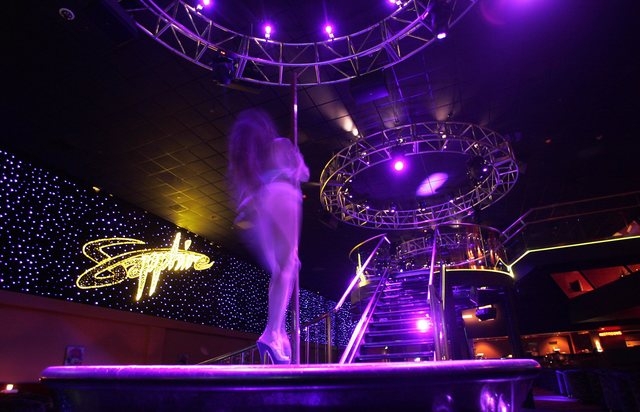Nevada strip clubs take two high court hits
CARSON CITY — It’s been a bit of a rough patch for Nevada’s strip club industry over the past couple of months.
In September, the Nevada Supreme Court said the clubs must pay the state live entertainment tax. The state Department of Taxation says the industry paid $3.76 million in live entertainment taxes in the fiscal year ending June 30.
The ruling means the clubs will have to continue to pay the levy to the state.
Then, on Oct. 30, the court ruled that dancers at one of the state’s biggest clubs, the Sapphire Gentlemen’s Club in Las Vegas, are employees of the business — not independent contractors — and must be paid at least minimum wage.
The successful class action case for as many as 6,000 current and former dancers who perform seminude could cost the club millions of dollars. The ruling is expected to apply to other strip club operators, although it won’t likely happen overnight.
The latest ruling creates myriad issues for the industry, which attorneys for the dancers say ultimately will be forced to comply with the ruling. From paying Social Security and Medicare taxes to contributing to the state unemployment insurance fund and providing workers’ compensation, the court’s decision will mean major changes for strip clubs.
There are also issues of health insurance, protection against sexual harassment and the right to unionize that come with the classification of dancers as employees and not independent contractors, said Tucson lawyer Mick Rusing, one of the attorneys in the case who has been fighting the issue in Nevada for 20 years.
But the financial bottom line just for the retroactive wages for the 6,000-plus dancers who have worked at the club is significant, he said. It could total in the $20 million range just to get the dancers even through repayment of their dance, or house, fees, he said.
Those fees, paid by dancers to the club in exchange for being able to work, total about $3.5 million a year, Rusing said.
A Clark County judge or jury will have to make that determination, he said..
Marketdata Enterprises Inc., a market research publisher of “off-the-shelf” studies about service industries since 1979, said in February the strip club industry nationally is a mature $2.5 billion business that represents about 3,500 clubs and 350,000 exotic dancers.
Average revenues per small local facility are estimated at $471,000, but upscale clubs in areas such as Las Vegas “can do $50+ million,” the firm said.
EX-DANCER APPLAUDS RULING
Michele Cosper, a Las Vegas resident, former Sapphire dancer and one of the original plaintiffs in the case, said the decision has been a long time coming for the dancers.
“Five years is a long time to wait,” she said. “I hope that in the future, dancers will be able to perform without the stress of having to make your house fees.”
Customers who come into the clubs get bombarded now by dancers trying to cover their fees so they can make a living, Cosper said.
During her years at the club from 2002 to 2008, Cosper said she saw dancers who got injured and had no health insurance because of their independent contractor status. When a dancer was injured, a tip jar usually was placed in the locker room so other dancers could help pay the bills.
“This is supposed to be a legitimate business,” Cosper said. “You should not need a tip jar to survive.”
Cosper said she made a reasonable living, bringing in about $30,000 a year. But nowhere near the six figures the club said dancers were making.
“I worked a lot of hours,” she said.
Most dancers don’t think about what they will do in the future, Cosper said. With this decision, hopefully dancers will get Social Security and protections against sexual harassment.
“These guys will get what they can,” she said. “It’s that kind of environment.”
Sapphire dancers can perform onstage or perform “lap dances” for individual customers. They can also work bachelor parties or other events at club “VIP” rooms. There is also a pool area.
Dancers make their money on tips once the house fee is covered. The fee is based on the most lucrative times of day to work and can amount to $100 or more.
Cosper said dancers who don’t make their fees back get debits marked against them. Eventually they aren’t allowed to work anymore, she said.
But Las Vegas attorney Clyde DeWitt, who has represented various components of the adult entertainment industry for more than 30 years, said the entertainers aren’t independent contractors, but independent businesswomen, the majority of whom do not want to be treated as employees.
He compared the dancers to merchants who rent space at swap meets.
“They enjoy running their own little dancing businesses; and they make much more money that way than they might otherwise, because they are rewarded for working hard,” he said by email in response to a request for comment. “Also, as employees they are subject to control of the club, so they could be assigned duties other than entertaining that are less rewarding.”
DeWitt said lawyers who can recover attorneys fees seek out a few entertainers to bring a lawsuit.
“The lawyer turns it into a class action and a stickup against the club,” he said.
ENTERTAINMENT TAX HIT
In the live entertainment tax case, eight strip clubs had argued they should not have to charge patrons 10 percent on an admission fee because exotic dancing should be considered free expression, a First Amendment-protected activity.
The live entertainment tax is two-tiered with a 10 percent tax rate and a 5 percent tax rate based upon the maximum occupancy of the facility where live entertainment is taking place. It took effect in 2004 and now applies both to gaming and nongaming businesses. The nongaming portion generated $14.9 million in the 2014 fiscal year.
The clubs had asked the Nevada Supreme Court to throw out the tax, saying it unfairly singles out the adult industry.
The court disagreed, finding that an examination of the levy shows it is “neither directed at nor presents the danger of suppressing particular ideas. Moreover, nothing in the record gives us reason to believe that (the tax) poses any danger of suppressing ideas.”
There are 30 strip clubs in Las Vegas and 12,000 dancers registered with the Metropolitan Police Department, according to a 2012 UNLV study.
While the live entertainment tax dispute appears to be settled for good, that might not be the case for the Sapphire dancers and those working under similar conditions at other clubs.
Las Vegas attorney Tom Christensen, another attorney involved in the lawsuit on behalf of the dancers, said it might take some time before the industry changes as a result of the decision.
“This is not the first time this has happened,” he said of the ruling. “The tendency of the industry is to keep up the charade of the dancers as independent contractors. It may take a few more of these cases to make it happen.”
The next step for the Sapphire dancers will be to determine damages at the District Court level, Christensen said. But lawsuits against other clubs are now likely as a result of the ruling, he said.
Whether the industry complies or tries to figure out a way around the decision remains to be seen, Christensen said.
An attorney for the club did not return calls seeking comment on the decision.
Sapphire Gentlemen’s Club maintained it merely provided a venue for the dancers to perform as independent contractors.
Rusing said the women who served as representatives of the class in the case deserve credit for putting up with the harassment from club representatives over the years.
“They came after these girls, called them names and treated them disrespectfully,” he said. “It is a huge victory affecting thousands of hardworking women in the state of Nevada.”
Contact Capital Bureau reporter Sean Whaley at swhaley@reviewjournal.com or 775-687-3900. Find him on Twitter: @seanw801.



































